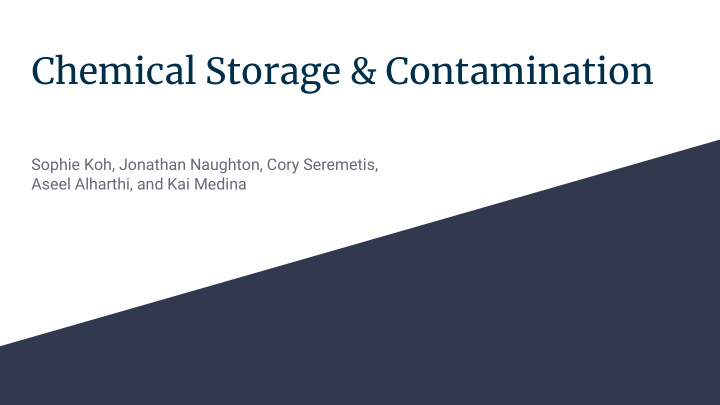



Chemical Storage & Contamination Sophie Koh, Jonathan Naughton, Cory Seremetis, Aseel Alharthi, and Kai Medina
The Problem
The Problem ● Bhopal Disaster in India → led to the passage of the 1986 Emergency Planning and Community Right-to-Know Act. ● Love Canal (1978) ○ Brief History ■ 1940s/50s → Hooker Chemical Corporations ○ Cause and Effect ○ EPA Involvement ○ Today: Impacts of the Love Canal ■ “Many residents in the area, which was deemed safe by authorities, claim to be facing health problems” (2018, PBS)
The Problem ● Hazardous Materials Processing regulation (527 CMR 33) ○ Implementation and Reasoning ■ Fire and explosion in Danvers, MA (2006) ● CSB Investigation and Recommendation ■ Middleton Chemical Plant Explosion, MA (2005) ● Conservation Law Foundation vs. Exxon (Mystic River) ○ Failing to protect fuel storage tank farm from climate change
Objectives ~ Ranking facilities will help prioritize emergency preparedness efforts ~ We can utilize maps and flow models to prevent dangerous contamination ~ Watershed associations, fire departments, and planning agencies can use these tools to better design safety planning
Strategy Understand Regulations Pertaining to Toxics Chemical Storage Contamination Release Calculate a Compute a Score Develop a Way to Combine and Weighted Score Based on 5 Key Model Potential Analyze the Data to Prioritize Criteria Flow Facilities Map the Prioritized Model Potential Flow Facilities For Multiple 21E Sites Identify Sites Requiring Safety Planning
Chemical Storage
Red dots = Tier II facilities Data Included Environmental Justice Boundaries Sites with chemicals (Chapter 21E, Tier II, etc.) Administrative boundaries https://mass-eoeea.maps.arcgis.com/apps/webappvie wer/index.html?id=485fe2bea40f49d3944a58ed368a7b 4d Map of Massachusetts Toxics Users and Vulnerability Climate Factors
Explanation of the Data EPA List of Lists Tier II Data Both include: - CERCLA RQ - Facilities 1. Type of - EPCRA: - Street Address - EHS Section 304 RQ - Average Quantity chemical - Section 313 (from Tiffany Skogstrom) 2. CAS Code (taken from epa.gov)
Devising a scoring system ● Combined data by matching chemical information with the City data using the CAS code ● Give each data point a weighted value: Final Weight: [Reportable Quantity Weight + 3 if its a 313] * Average Quantity of Chemical Reportable 10 100 500 1000 5000 10000 Quantity Weighted 9 8 7 6 5 3 Value
Devising a scoring system Sorted by weighted value and the selected ● cities within the Mystic River Watershed ● Removed solids that were less likely to be impacted during an emergency
Priority Chemicals Chemical Name CERCLA RQ Chemical Name CERCLA RQ Ammonium Hydroxide 1000 Nitric Acid 1000 Aqueous Ammonia 100 Phenols 1000 Lead acid (battery acid) 10 Potassium cyanide 10 Chlorine - any forms 10 Potassium Hydroxide 1000 Cyanide - any forms 1 Sodium Hydroxide 1000 Hychloric acid 5000 Styrene monomer 100 Lead acid (battery acid) 10 Sulfuric Acid 1000 Methylethylketone 5000 Toluene 1000
Geocoding on Google Sheets Scoring Completion of Addresses System “Concatenate” “Address2zip” Prioritized Data: Consolidation of Scores >/= Transfer to ArcGIS facilities 50,000 Database layers: Add on “Geocode (Location, -Geocoded Tier II by Awesome Chemical type) Facilities Table” -Town Boundaries (source MassGIS) -Mystic River Watershed
Contaminated Sites
Methods - Mapping Workflow: Data Layers Used: 1. Used sites to select the watershed boundary 1. Elevation and Shaded Relief 2. Clipped elevation data to watershed boundary (MassGIS) 3. Ranked sites based five key attributes to determine how dangerous 2. Hydrography (MassGIS) they are 3. Watershed Boundaries 4. Ran Fill, Flow Direction, and Flow accumulation algorithms on (MassGIS) elevation data 4. 21 E sites (Katelyn) 5. Created Maps showing flow accumulation for top 5 worst sites
Methods-Mapping ● Score was computed based on 5 attributes ● Each attribute was either a zero or a one ● Room for improvement, coefficients Open_site + ARS + AEPMM + Critical_Exp_Pathway + Imm_Hazard 0.5*Open_Site + 0.75*ARS + 1.25*AEPMM + 2.0*Critical_Exp_Pathway + 1.2*Imm_Hazard + Other Variables?
Methods-Mapping How Fill Works: *without this nothing will work*
Methods-Mapping How Flow Direction Works: How Flow Accumulation Works:
Results
Results- Chemical Storage - Chemical Storage Catalogue 1 (scores between 50,000-100,000) - Chemical Storage Catalogue 2 (scores over 100,000) - Most common chemical on final list: sulfuric acid, aerosol form (23 facilities) Marshalls Woburn Distribution Center NITCO Materials Handling Solutions Kraft Heinz Company Score: 2,228,580 Score: 1,813,020 Score: 1,291,242 Chemicals: lead, battery acid Chemicals: battery acid Chemicals: sulfuric acid
Chemical Storage Facilities in Mystic River Watershed
Focused Clusters of Facilities
Results-Contamination
BP Gas
Dental Building
SnapMart
Dry Cleaners
Beaumont School
ExxonMobile
Further Goals Chemical Storage Project Contamination Project - Refine scoring system - Refine Scoring system - Explore data without weighted - Buffer (200m, 100m, 50m) scores (ex. Petroleum, Hydraulic Acid, Propane, Diesel) - Create prioritized data for other chemicals - Map prioritized data onto FEMA flooding map → locate facilities in areas vulnerable to flooding
Recommend
More recommend